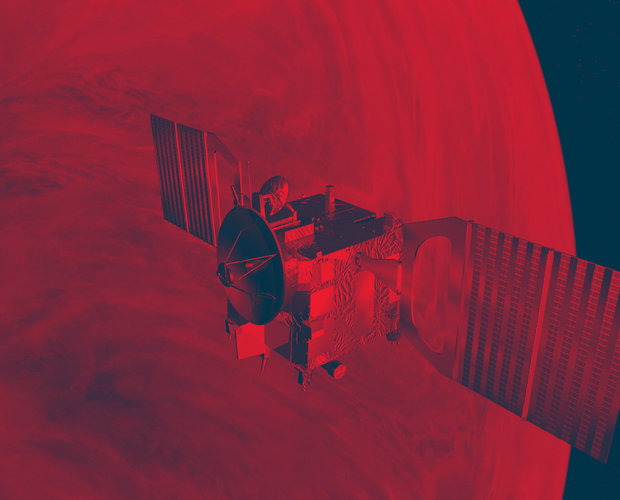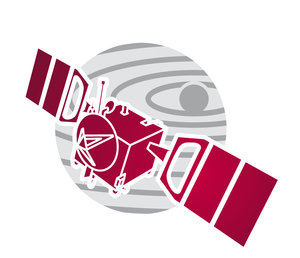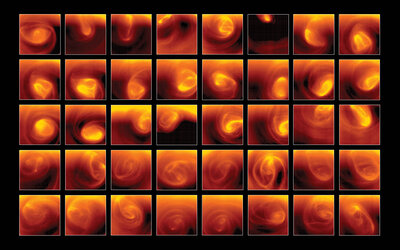Venus Express rises again
After a month surfing in and out of the atmosphere of Venus down to just 130 km from the planet’s surface, ESA’s Venus Express is about to embark on a 15 day climb up to the lofty heights of 460 km.
Since its arrival at Venus in 2006, the spacecraft has been conducting science observations from an elliptical 24-hour orbit that took it from a distant 66 000 km over the south pole – affording incredible global views – to altitudes around 250 km at the north pole, just above the top of the planet’s atmosphere.
After eight years in orbit and with fuel for its propulsion system running low, a daring aerobraking campaign was planned as a final assignment for Venus Express, during which it would dip progressively lower into the atmosphere on its closest approaches to the planet.
Thus routine science operations concluded on 15 May, and the spacecraft’s altitude was allowed to drop naturally from the effect of gravity, culminating in a month ‘surfing’ between 131 km and 135 km above the surface.


Access the video
Additional small thruster burns were used to drop the spacecraft to lower altitudes, reaching 130.2 km earlier this week. Tomorrow, it is expected to dip to 129.1 km.
“We have explored uncharted territory, diving deeper into the atmosphere than ever before,” says Håkan Svedhem, ESA’s Venus Express project scientist.
“We’ve measured the effects of atmospheric drag on the spacecraft, which will teach us how the density of the atmosphere varies on local and global scales.”
Indeed, the additional drag exerted by the denser atmosphere at lower altitudes reduced the spacecraft’s orbital period by more than an hour.
Small changes in the spacecraft’s acceleration were also recorded due to variations in the atmospheric density along its orbital path. Differences in acceleration were also noticed between the day and night side of the planet.
The forces experienced by the spacecraft at different altitudes equate to a difference in atmospheric density of about thousand times between 165 km and 130 km, causing significantly increased stress on the spacecraft.
Indeed, the Venus Express team monitored the rapid heating that the spacecraft experienced as it skimmed through the upper reaches of the atmosphere during each orbit at about 36 000 km/h.
“During several of the 100-second long passages through the atmosphere, the solar panel temperature sensor reading increased by over 100ºC,” describes Adam Williams, ESA’s Venus Express spacecraft operations manager.
“Analysing the spacecraft’s response to such rapid heating will be useful for planning future spacecraft systems and subsystem design.”
Continue reading below
Commands have now been sent to the spacecraft ready to begin a series of 15 manoeuvres that will raise the lowest part of the orbit to about 460 km. These begin tomorrow and should be completed by 26 July.
Once Venus Express reaches this higher altitude orbit it will be allowed to decay naturally, eventually sinking into the atmosphere by December, ending its mission.
However, it is possible that the remaining fuel will run out during the thruster burns required to raise its orbit.
If this occurs, it will no longer be possible to communicate with the craft and its orbit will once again decay.
“We have already gained valuable experience in operating a spacecraft in these challenging conditions that will be important for future missions that may require it. Once we have completed the orbit raise, we look forward to processing and analysing the scientific data collected on the atmosphere,” says Patrick Martin, ESA’s Venus Express mission manager.
For updates during the orbital raising manoeuvres follow the Rocket Science Blog and @esaoperations on Twitter.
Notes for Editors
The recorded atmospheric density at an altitude of 165 km was 10-11 kg/m3 and at 130 km it was 10-8 kg/m3. While these values may seem small – atmospheric density at Earth’s sea level is 1 kg/m3 – the density is a thousand times greater at the lowest altitudes.
On Monday 7 July, Venus Express completed 3000 orbits around Venus.
For more information, please contact:
Markus Bauer
ESA Science and Robotic Exploration Communication Officer
Tel: +31 71 565 6799
Mob: +31 61 594 3 954
Email: markus.bauer@esa.int
Håkan Svedhem
ESA Venus Express project scientist
Email: hakan.svedhem@esa.int
Adam Williams
ESA Venus Express spacecraft operations manager
Email: Adam.Williams@esa.int
Patrick Martin
ESA Venus Express mission manager
Email: pmartin@sciops.esa.int









